Four Blood Moons: Total Lunar Eclipse Series Not a Sign of Apocalypse
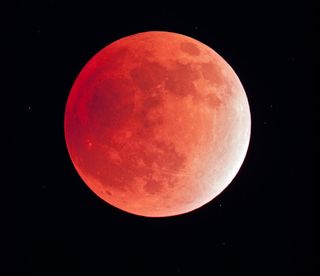
Editor's update for Sept. 2015: To find out more about the rare supermoon lunar eclipse of Sept. 27-28, 2015 and how to see it, visit: Supermoon Lunar Eclipse 2015: Full 'Blood Moon' Coverage
There has been a lot of interest recently in an upcoming series of lunar eclipses that begins April 15. These are usually described as "four blood moons" and taken by some to prophesy upcoming disasters.
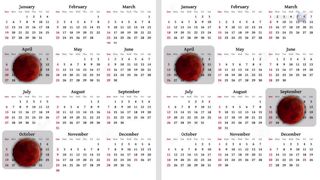
The total lunar eclipse of April 15 will begin a so-called tetrad series of eclipses that is making the rounds online as a potential harbinger of doom, due in part to a recent book on the four blood moons that makes the dubious claim.
Astronomers rarely if ever use the term blood moon. When they do, they are usually using it as an alternate name for the Hunter's Moon, the full moon that follows the Harvest Moon, usually in late October. The Hunter's Moon, like the Harvest Moon, rises slowly on autumn evenings so that it shines through a thick layer of the Earth's atmosphere, and is colored red by Rayleigh scattering and air pollution. [Four Blood Moons: Lunar Eclipse Tetrad Explained (Video)]

Lunar eclipses explained
A lunar eclipse is something quite different. It occurs when the moon passes through the Earth's shadow.
The Earth's shadow consists of two parts: a dark inner core called the "umbra," and a lighter outer part called the "penumbra." Rather than being truly dark, the inner shadow is usually tinted orange or red by light passing through the ring of atmosphere surrounding the Earth.
Get the Space.com Newsletter
Breaking space news, the latest updates on rocket launches, skywatching events and more!
Depending on the atmospheric conditions on Earth in the band of atmosphere through which the sun's light is passing, the umbra may take on a range of colors from light coppery-red to almost total black. The light illuminating an eclipsed moon is coming from thousands of sunsets and sunrises around the Earth. During some eclipses, these sunsets and sunrises are clear, and much light passes through; during others, clouds may block the light, causing a dark eclipse.
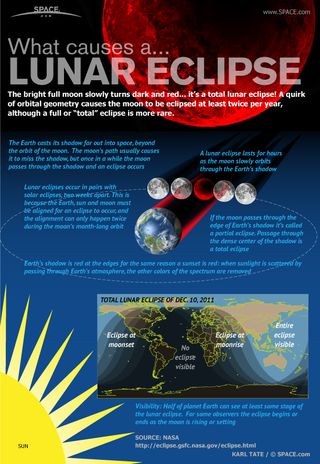
The blood moon
On rare occasions, the light reaching the moon is exactly the color of blood, but there is no way of predicting this in advance. So there are no grounds to call any particular lunar eclipse a blood moon until it actually shows its color.
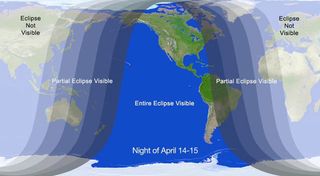
Because the moon's orbit is slightly tilted with respect to the sun's path across the sky, most of the time the moon passes above or below the Earth's shadow, and no eclipse occurs. Sometimes it passes only through the penumbra and produces what is called a penumbral eclipse, a moon so lightly shaded that the casual observer might not even notice a difference. There were two such penumbral eclipses in 2013, on May 25 and Oct. 18. [Total Lunar Eclipses: Blood Red Moon Explained (Video)]
Sometimes the moon only dips slightly into the central shadow, and it produces a partial lunar eclipse. One of these occurred last year, on April 25.
The rarest of all lunar eclipses are those in which the moon passes through the darkest part of the shadow, a true total lunar eclipse. This last happened on Dec. 10, 2011.
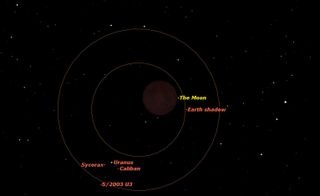
Four Blood Moons: The lunar eclipse tetrad
What is unusual about this month's lunar eclipse is that it is the first of a series of four total lunar eclipses in a row. Called a tetrad, such a series of four total eclipses in a row is a fairly rare event. The last such series happened in the years 2003 and 2004. It will only occur seven more times in the current century.
So while a tetrad of total lunar eclipses is somewhat rare, it is not extraordinarily so, and probably nothing to make a fuss about. After all, the only thing that happens during a lunar eclipse is that the moon spends a couple of hours passing through the Earth's shadow, hardly something to be concerned about.
Unfortunately, there are still many superstitious people in the world. Such is the case in the book "Four Blood Moons: Something Is About to Change" (Worthy Publishing, 2013) by John Hagee, which suggests a link between the new total lunar eclipse tetrad and biblical prophecy about the end times.
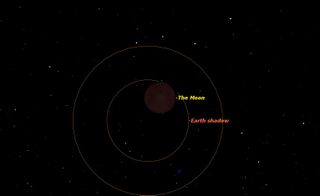
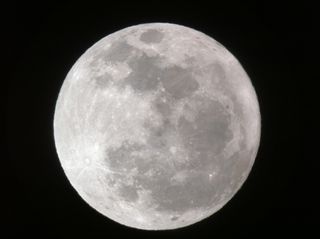
Associations between "disastrous" events and normal astronomical events are all fabrications of the human mind, as people attempt to find explanations for why disasters affect them. Because of the Internet and cable news channels, people now hear reports of disasters from around the world, including earthquakes, tsunamis and volcanic eruptions, which they never would have been aware of in the past. It's almost inevitable that something bad will happen right after an eclipse or a visit from a comet.
As an ardent skywatcher who derives much pleasure from beautiful events like lunar eclipses, it saddens me that there are "prophets of doom" in the world who view these life-enriching events as portents of disaster.
The good news about these forthcoming lunar eclipses is that all four will be visible to most skywatchers in North America. I hope that you will manage to observe one or more of them, and share their beauty with your friends. The eclipse on April 15 will require most North Americans to stay up into the wee hours of the morning, but it will be well worth it.
Editor's Note: If you snap an amazing picture of the April 15 total lunar eclipse or any other night sky view that you'd like to share for a possible story or image gallery, send photos, comments and your name and location to managing editor Tariq Malik at spacephotos@space.com.
This article was provided to Space.com by Simulation Curriculum, the leader in space science curriculum solutions and the makers of Starry Night and SkySafari. Follow Starry Night on Twitter @StarryNightEdu. Follow us @Spacedotcom, Facebook and Google+. Original article on Space.com.
Join our Space Forums to keep talking space on the latest missions, night sky and more! And if you have a news tip, correction or comment, let us know at: community@space.com.

Geoff Gaherty was Space.com's Night Sky columnist and in partnership with Starry Night software and a dedicated amateur astronomer who sought to share the wonders of the night sky with the world. Based in Canada, Geoff studied mathematics and physics at McGill University and earned a Ph.D. in anthropology from the University of Toronto, all while pursuing a passion for the night sky and serving as an astronomy communicator. He credited a partial solar eclipse observed in 1946 (at age 5) and his 1957 sighting of the Comet Arend-Roland as a teenager for sparking his interest in amateur astronomy. In 2008, Geoff won the Chant Medal from the Royal Astronomical Society of Canada, an award given to a Canadian amateur astronomer in recognition of their lifetime achievements. Sadly, Geoff passed away July 7, 2016 due to complications from a kidney transplant, but his legacy continues at Starry Night.
Most Popular

